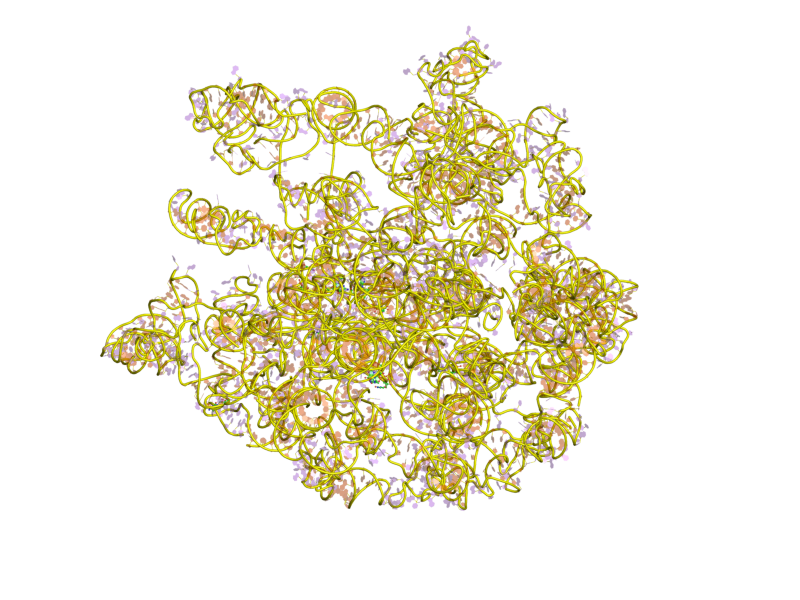23S Ribosomal RNA on:
[Wikipedia]
[Google]
[Amazon]
 The 23S
The 23S
Pseudobase entry for pseudoknot of the 23S ribosomal RNA (PKB00148)
{{Ribosome subunits Ribosomal RNA
 The 23S
The 23S rRNA
Ribosomal ribonucleic acid (rRNA) is a type of non-coding RNA which is the primary component of ribosomes, essential to all cells. rRNA is a ribozyme which carries out protein synthesis in ribosomes. Ribosomal RNA is transcribed from riboso ...
is a 2,904 nucleotide
Nucleotides are organic molecules consisting of a nucleoside and a phosphate. They serve as monomeric units of the nucleic acid polymers – deoxyribonucleic acid (DNA) and ribonucleic acid (RNA), both of which are essential biomolecul ...
long (in '' E. coli'') component of the large subunit (50S
The 50s decade ran from January 1, 50, to December 31, 59. It was the sixth decade in the Anno Domini/Common Era, if the nine-year period from 1 AD to 9 AD is considered as a "decade".
Significant people
* Claudius, Roman Emperor (AD 41� ...
) of the bacterial/archean ribosome and makes up the peptidyl transferase center (PTC). The 23S rRNA is divided into six secondary structural domains titled I-VI, with the corresponding 5S rRNA being considered domain VII. The ribosomal peptidyl transferase
The peptidyl transferase is an aminoacyltransferase () as well as the primary enzymatic function of the ribosome, which forms peptide bonds between adjacent amino acids using tRNAs during the translation process of protein biosynthesis. The sub ...
activity resides in domain V of this rRNA, which is also the most common binding site for antibiotics that inhibit translation, making it a target for ribosomal engineering. A well-known member of this antibiotic class, chloramphenicol
Chloramphenicol is an antibiotic
An antibiotic is a type of antimicrobial substance active against bacteria. It is the most important type of antibacterial agent for fighting pathogenic bacteria, bacterial infections, and antibiotic medica ...
, acts by inhibiting peptide bond formation, with recent 3D-structural studies showing two different binding sites depending on the species of ribosome. Numerous mutations in domains of the 23S rRNA with Peptidyl transferase activity have resulted in antibiotic resistance. 23S rRNA genes typically have higher sequence variations, including insertions and/or deletions, compared to other rRNAs.
The eukaryotic homolog of the 23S LSU rRNA is the 28S ribosomal RNA
28S ribosomal RNA is the structural ribosomal RNA (rRNA) for the large subunit (LSU) of eukaryotic cytoplasmic ribosomes, and thus one of the basic components of all eukaryotic cells. It has a size of 25S in plants and 28S in mammals, hence th ...
, with a region filled by the 5.8S ribosomal RNA
In molecular biology, the 5.8S ribosomal RNA (5.8S rRNA) is a non-coding RNA component of the large subunit of the eukaryotic ribosome and so plays an important role in protein translation. It is transcribed by RNA polymerase I as part of the 4 ...
.
23S rRNA Functions
In general, rRNA has an essential function of peptidyl transferase. The stimulating core of the ribosome plays role in the peptide bond configuration. Both peptidyl-tRNA and aminoacyl-tRNA are important for protein synthesis and transpeptidation response.Essential Bases
However, 23S rRNA positions (G2252, A2451, U2506, and U2585) have a significant function for tRNA binding in the P site of the large ribosomal subunit. These modification nucleotides in site P can inhibit peptidyl-tRNA from binding. U2555 modification can also intervene with transferring peptidyl-tRNA to puromycin. Furthermore, the chemical modification of half of these positions G2251, G2253, A2439, and U2584 can not prevent the tRNA binding. Peptidyl-tRNA of 50S subunits which binds to the P site preserve eight positions of 23S rRNA from chemical modification. On the other hand, mutation in 23S rRNA can also have impacts on cell growth. Mutations A1912G, A1919G and Ψ1917C have a powerful growth phenotypes and they prevent translation while mutation A1916G has a simple growth phenotype and it leads to defect in the 50S subunits.23S rRNA Helix 26a
The 23S ribosomal RNA is composed of six domains forming a complex network of molecular interactions. A central single-stranded region connects all of the domains through base-pairing of the two halves, forming Helix 26a. Some consider Helix 26a to be Domain 0 due to its action as a central core and compact folding unit. Comparison of 23S and 28S ribosomal RNA sequences across species demonstrate conservation of Helix 26a. Helices continue to provide the support as the backbone of domain architecture.Plastid
Chloroplast ribosomes from "higher" plants have an additional 4.5S rRNA created by fragmentation of 23S. It is located to the 3' side of 23S in therRNA operon
Ribosomal DNA (rDNA) is a DNA sequence that codes for ribosomal RNA. These sequences regulate transcription initiation and amplification, and contain both transcribed and non-transcribed spacer segments.
In the human genome there are 5 chro ...
and corresponds to the 3' end of non-fragmented 23S rRNA.
See also
*23S methyl RNA motif
The 23S methyl RNA motif is a conserved RNA structure found upstream of genes predicted to encode rRNA methyltransferases, possibly for 23S rRNA. However, in one case it is far (3 kilobases) from the rRNA methyltransferase gene. Nonetheless, ...
* LSU rRNA
References
External links
*Pseudobase entry for pseudoknot of the 23S ribosomal RNA (PKB00148)
{{Ribosome subunits Ribosomal RNA